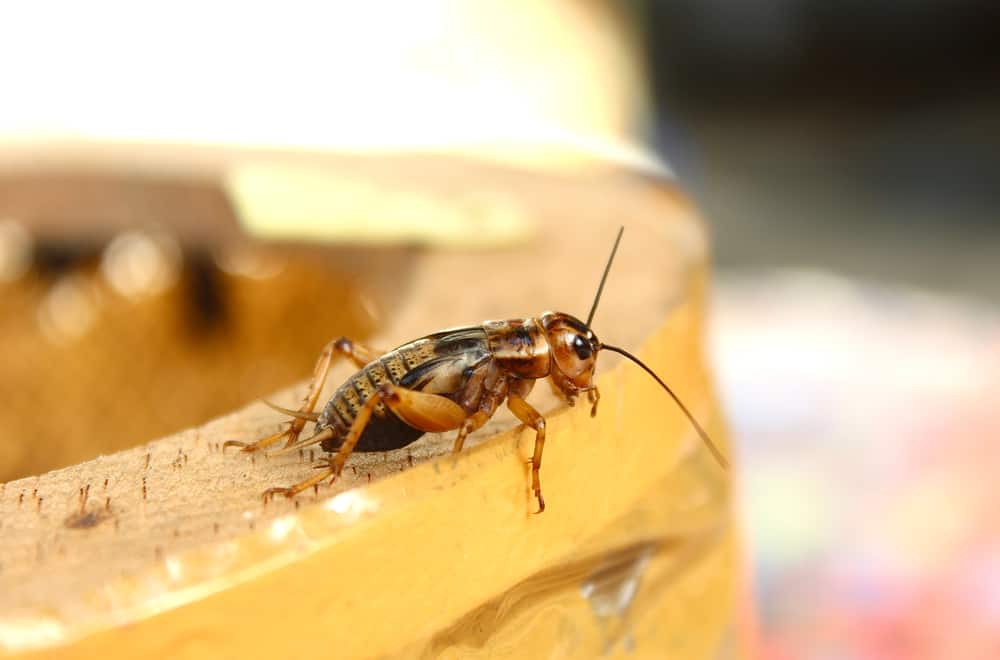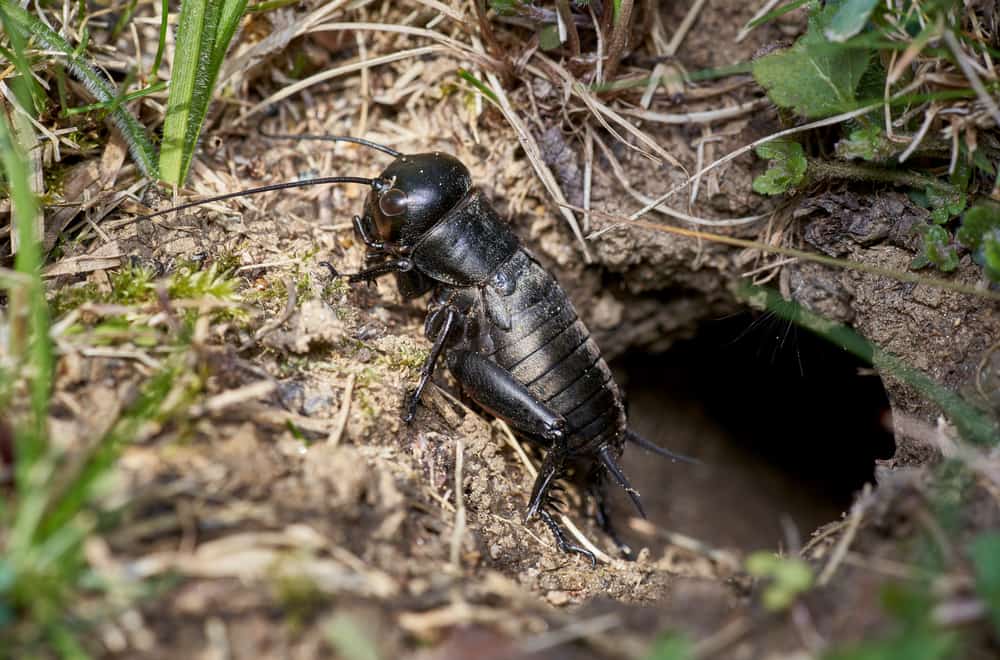Why Do You Feed Crickets Potatoes
Has the sound of a cricket chirping ever woken you up at night? There's a lot of folk culture surrounding crickets, as some cultures view crickets as good luck, others as a symbol of hope, and some as death. Crickets eat many foods but can't live without protein in their diet.
So, what do crickets eat?
Cricket Habits And Biology
Did you know that adult crickets can last up to two weeks without food? According to scientists, this is possible. Though crickets can last this long without food, it may surprise you to know that they are also cannibals that prey on weaker crickets if there's nothing else to eat.
Talk about survival of the fittest.
There are nine hundred known species of crickets. Wow! That's quite a lot. They belong to the family grillidae and are related to grasshoppers. Also, crickets have two pairs of wings, long antennae, and chirp using their fore wings by rubbing the wings together.

Crickets eat a wide variety of foods because they are omnivorous- they eat both plants and meat. A proper diet for crickets is essential whether you keep them as pets or feeder crickets for another pet, such as lizards (gecko) and snakes. Crickets are primarily nocturnal.
Keeping crickets captive as prey for your pets is a good choice as they contain essential nutrients and vitamins that your pet needs to be healthy. On the flip side, if you don't feed your crickets well, they won't be a good food source for your pet.
If you prefer to keep crickets as pets, you need to regularly give them enough food and clean water.
Did you know that male crickets are pretty romantic? That's right. Only male crickets can chirp and attract females. Also, crickets can be brown or black.
Crickets only chirp when the temperature is hot, and if it falls below 55 degrees Fahrenheit, they refuse to chirp. You would think the sight of a female would be enough to get them chirping, but apparently, it all boils down to how hot the weather is.
What do crickets like to eat most?
There is no shortage of what crickets can eat as they eat both fresh and dry foods. Offer crickets fresh foods in moderation as these foods tend to mold fast. Wild crickets and house crickets alike have so many options available to them.
Did you know that crickets can also eat fabric, clothing, and other household items, including furniture? The list below talks about what foods they mostly like to eat. Let's get started:
- Romaine lettuce- Have some left-over salad? Please don't throw it away; feed it to your crickets. Lettuce is rich in potassium, vitamin K and A, all of which are healthy for crickets.
- Carrots- Crickets love to eat peeled and also cooked carrots. Carrots are healthy for crickets as they contain beta-carotene and water.
- Cabbage- Feed crickets the outer cabbage leaves you usually don't use- these leaves will supply vitamin K and C to your crickets.
- Potatoes and squash- Potatoes are a starchy food, and you can feed crickets potato peelings which you may otherwise throw away.
- Cricket chow- This is commercial food specifically made for crickets.
- Fruits- Apples, oranges, bananas, grapes, and berries- Fruits are an excellent food choice for crickets. Did you know that apples contain a lot of water that helps crickets to stay hydrated? Oranges have vitamin C.
- As for bananas, they are rich in potassium. Make sure to cut bananas and apples into pieces before feeding them to crickets.
- Seeds and nuts- You can feed your crickets with nuts like almonds, peanuts, pumpkin seeds, and raw sunflower seeds. These seeds are highly nutritious. So yummy.
- Bread, cornflakes, and biscuits- You can feed crickets some of your favorite foods as well. It seems like crickets can eat just about anything. Try not over-feed crickets these foods.
- Grains- Grains such as alfalfa, rice cereal, and wheat germ are good for crickets.
- Pet food- Dry cat food, dry dog food, and reptile food. Crickets love cat food and dog food which you should crush finely before feeding it to them.
- Greens- Greens such as collard greens, mustard greens, dandelion leaves, broccoli, and kale are healthy for crickets.
- Poultry mash
- Chicken scraps
- Small insects (ants, ladybugs), crops, fungi, and mulch- Wild crickets generally eat these foods, among others, and can find these foods around your lawns and yards.
- Mulch in the form of plant stems and plant grass clippings; wild crickets love to eat these.
- Wild crickets in fields and forests find and eat foods such as eggs and pupae of insects, dead animals, and decaying plant matter.
- If a large number of wild crickets access your yard, they can destroy your crops and vegetables and cause much damage to rows of seedlings.
Foods that crickets eat depend on their environment. You can't expect a wild cricket to eat cat food when it's out in the wild. Only captive crickets mostly eat the foods mentioned above.
A combined diet of fresh foods and dry foods will give crickets a well-rounded high-quality diet. Crickets that are well-fed have no cannibalistic tendencies. Cannibalism is when crickets eat other crickets.
Foods To Avoid Feeding Crickets

Crickets, like all other creatures, have do's and don'ts as well. There are particular food and non-food substances that, when ingested by crickets, could prove to be harmful. Such items include:
- When mixed with water in a high enough concentration, vinegar can kill a cricket in about a minute. Therefore avoid giving the mixture to crickets lest you are planning on killing them.
- Saltwater has also been found to play a fatal role in this bugz life. When mixed with water or in raw form, it shouldn't be fed to crickets as it is known to harm and kill them.
- Lemon, a citrus fruit, is acidic by nature. If drunk by a cricket, it will be killed on the spot.
- Baking soda is highly dangerous for crickets as well. When mixed with water in a bowl and left in the open, crickets may accidentally jump in. This will, in turn, lead to death through drowning.
- If taken by a cricket, neem oil disrupts its hormones after ingestion, which, in turn, causes them to stop eating, drinking, and reproducing resulting in death.
- Cedar oil dehydrates them and emulsifies their body fats, eventually leading to death if given to crickets.
If you want your crickets to remain alive and safe, avoid giving them the above foods at all costs.
Tips to Feed Crickets
Crickets can be kept in a cage, a deep container, or an aquarium. Regardless of where you keep your crickets, you should know the best ways to feed them. Let's look at how best to feed them.
- The food you feed your crickets needs to be placed firmly on the ground in an open and shallow container.
- Regularly clean the food container to remove dead crickets and waste to prevent mold from developing.
- Did you know that crickets can't swim? Your crickets will drown if you put a bowl of water in their cage or container.
- For crickets to safely drink water, dampen items like a sponge, cotton balls, and paper towels with water and put them in their cage.
- Alternatively, you can fill a shallow lid with water and add stones to the cover to help crickets maintain balance.
- Would you please keep food separate from water to keep the food dry? If the food gets wet, it will develop molds.
- You must regularly supply your crickets with food to keep them from feeding on each other.
- You need to remove any uneaten food from the cage to keep molds away. Fresh foods especially can easily mold.
- Crickets self-regulate the food they eat; this means there's no need for you to measure the amount of food you give them.
As crickets have a lifespan of 8- 10 weeks, they are mostly kept as food sources by pet owners. These crickets should be kept aside for gut-loading.
Gut-loading is when you feed your crickets nutritious foods to pass on these nutrients to your pets. What better insect can you find to feed your pets? Also, while gut-loading, you can dust crickets in calcium supplements before you feed them to your pet.
Frequently Asked Questions (FAQS)
Do crickets bite humans?
There are a few species that bite humans due to their large jaws.
Why do crickets eat small insects?
Crickets eat insects because they need protein in their diet. Crickets themselves are high in protein.
Why do crickets need to be kept in a hot environment?
Crickets can develop fungus in a humid (wet) environment, and that's why you should keep them warm while in captivity.
Summary
No need to ask yourself anymore what you can feed your crickets. As crickets love to eat a wide range of foods, feeding them becomes a lot easier. Just make sure the food you feed your crickets is well balanced, a combination of fresh and dry foods.
Source: https://www.atshq.org/what-do-crickets-eat/
0 Response to "Why Do You Feed Crickets Potatoes"
Post a Comment